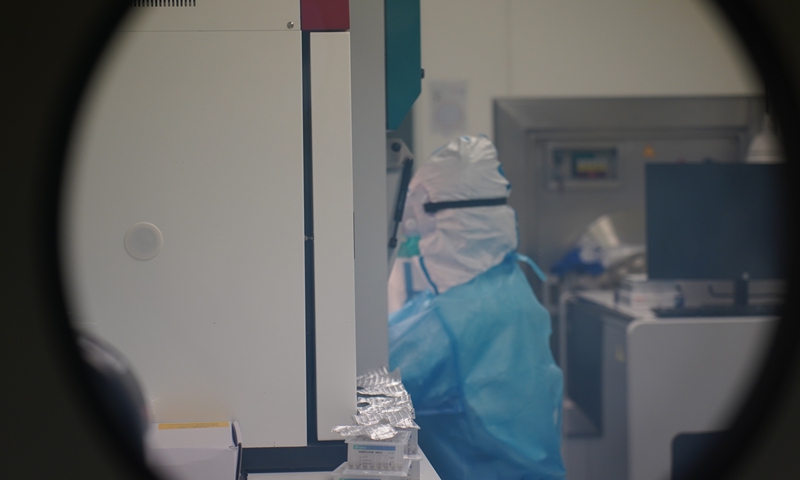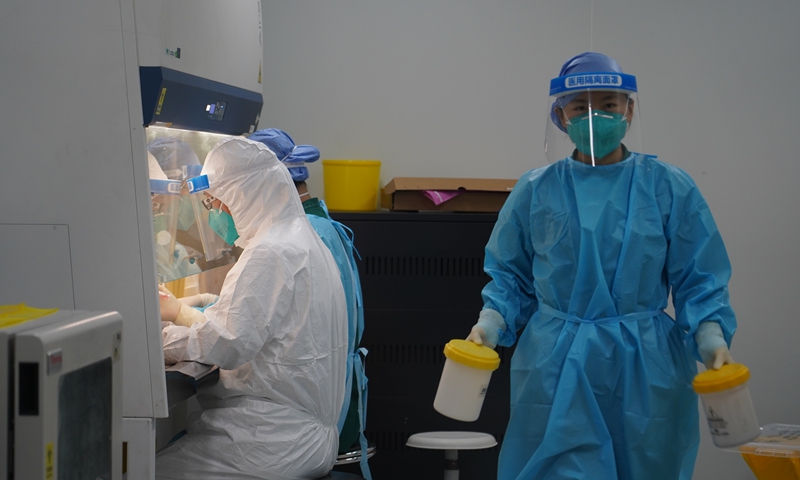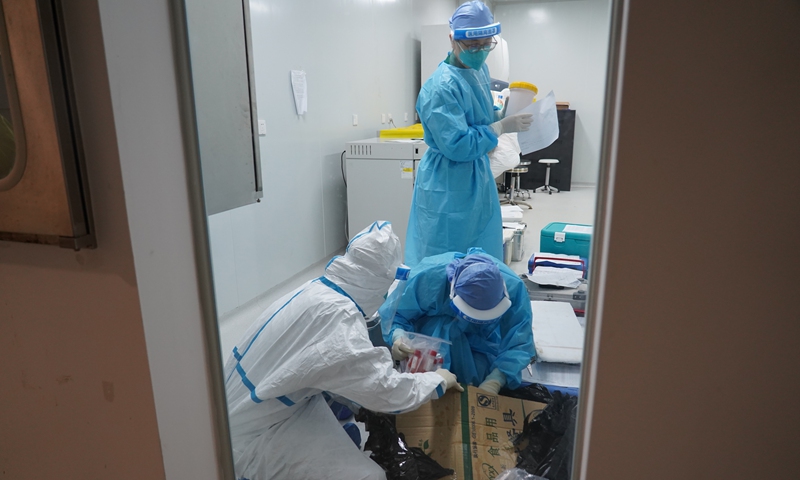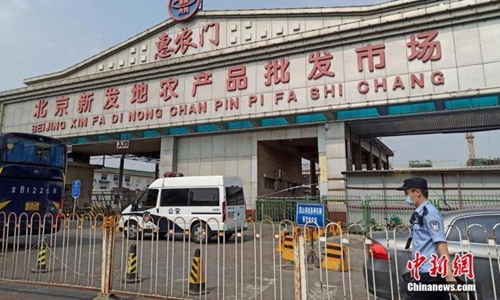IN-DEPTH / IN-DEPTH
Visiting the mobile P3 lab that contributed to curbing COVID-19 in Beijing
Mobile P3 lab removed after COVID-19 epidemic contained in Beijing
As Beijing's latest COVID-19 outbreak ebbs, the Chinese Center for Disease Control and Prevention (CDC) withdrew a high-level mobile biosafety lab on Sunday, which tested thousands of acid samples during the height of the infection scare in the city.
The protection level 3 (P3) lab was parked in Huangxiang Fengtai district, where the latest outbreak began in Beijing, as the Global Times reporter took an up-close look in the facility, which looked like an ordinary cargo container from outside.
The city of Beijing reported no new COVID-19 cases for eight consecutive days on Tuesday.
After the recent wave of novel coronavirus broke out in Xinfadi market of Fengtai district, the Chinese CDC mobilized the P3 lab to help increase daily nucleic acid test capability.
Previously this year, the mobile P3 labs served in cities such as Wuhan of Central China's Hubei province and Mudanjiang of Northwest China's Heilongjiang Province when the epidemic was hitting those regions.
Medical experts estimated China now has only 60 P3 labs, including three mobile ones.

"One of the most outstanding features of the mobile P3 lab is that no room is needed, and just a small piece of land is everything that is needed for the establishment of the lab," said Kan Biao, deputy director of Chinese CDC and captain of the mobile P3 lab.
"Even in the wild without power, the lab can work with diesel," he said. A diesel power generation truck is also equipped to power the lab.
After the severe acute respiratory syndrome (SARS) in 2003, China has organized the mobile biosafety level 3 lab.
Equipped with various machines including a biosafety cabinet, nucleic acid isolation machine, RNA extraction kit, membrane sealer and mini centrifugal machine arranged in a 12-squaremeter space, there is little room left for operators.
Therefore, only four operators are allowed in the lab at the same time, said Zhao Hongqun, a deputy captain of the mobile P3 lab.
1,700 samples, 12 hours
The lab has two buffer zones. In the first zone, operators change their shoes and clothes, and wear protective caps and N95 masks. In the second, operators wear protective suits for BSL-3, and other protective equipment, and check each other before entering the core zone. It takes operators about an hour to change their clothes as it takes 20-30 minutes to put their protective equipment on, and the same time to take them off.
"Samples usually arrive in the evening, so operators have to work overnight," Xu Xuefang, a deputy research fellow of Chinese CDC, told the Global Times.
The P3 lab once tested 1,700 samples in 12 hours, Kan told the Global Times. In the past month, the lab tested a total of more than 10,000 samples.
After the samples are ready, they will be sent to the P3 lab via a passing channel mounted in the wall of the lab.

"The two doors cannot be opened at the same time, so that the environment outside the lab is free from contamination," Xu introduced.
Nucleic acid will be extracted from samples, and the extracted nucleic acid will be added with PCR reaction agent and sealed into a box with many holes, with each hole representing a sample.
These boxes will be sent to Xu in another lab to analyze the results.
The white box sealed with membranes will be put into a machine, and eight hours later, curves showing the results appear on the screen.
"Once a positive result is found, a second check is required immediately, and if the two results are identical, we will notify the local health authority and the patient for isolation and treatment," Xu said.
A moving virus tracer
Since the mobile lab was established in 2004, it has been seen after some major natural disasters, such as earthquakes, to prevent epidemic caused by the disasters.
In fighting against the COVID-19 epidemic this year, the mobile P3 lab has served in four cities across China, including Wuhan, Mudanjiang, Jilin city of Northeast China's Jilin Province, as well as Beijing.
Peng Yao and Yang Xiaowen have been working with the P3 lab in all the four cities since February. They stayed at home for only five days in the whole of the first half of 2020.
Kan told the Global Times that since the lab is biosafety level 3, nucleic acid of samples can be extracted directly without inactivation, which also helps save time.

In addition to nucleic acid tests, the mobile P3 lab also probes complete genome sequences of the COVID-19 virus, as the lab has two gene sequencing machines.
Viral genome sequencing would be done after the mobile lab arrives in a place. "After getting some positive samples, gene sequencing is needed to help analyze the epidemic and whether mutation occurred," said Kan.
"Samples don't need to be sent to a provincial or national P3 lab for gene sequencing, which saves time and is necessary in knowing about the virus, tracking the source, and judging the epidemic's development trend in a short period of time," Kan told the Global Times.
"A gene sequencing informs everything we need to know about whether the virus mutates," said Lu Xin, a deputy research fellow of the CDC, adding that "after analysis, we will know whether the virus evolves in terms of virulence and transmissibility."
Lu told the Global Times that genome sequencing found the COVID-19 virus prevalent in Beijing is similar with the virus in European and North and South American countries, but different with the virus in Wuhan in transmissibility.
The protection level 3 (P3) lab was parked in Huangxiang Fengtai district, where the latest outbreak began in Beijing, as the Global Times reporter took an up-close look in the facility, which looked like an ordinary cargo container from outside.
The city of Beijing reported no new COVID-19 cases for eight consecutive days on Tuesday.
After the recent wave of novel coronavirus broke out in Xinfadi market of Fengtai district, the Chinese CDC mobilized the P3 lab to help increase daily nucleic acid test capability.
Previously this year, the mobile P3 labs served in cities such as Wuhan of Central China's Hubei province and Mudanjiang of Northwest China's Heilongjiang Province when the epidemic was hitting those regions.
Medical experts estimated China now has only 60 P3 labs, including three mobile ones.

Lab operators work in the mobile P3 lab. Photo: Qu Qiuyan/GT
"One of the most outstanding features of the mobile P3 lab is that no room is needed, and just a small piece of land is everything that is needed for the establishment of the lab," said Kan Biao, deputy director of Chinese CDC and captain of the mobile P3 lab.
"Even in the wild without power, the lab can work with diesel," he said. A diesel power generation truck is also equipped to power the lab.
After the severe acute respiratory syndrome (SARS) in 2003, China has organized the mobile biosafety level 3 lab.
Equipped with various machines including a biosafety cabinet, nucleic acid isolation machine, RNA extraction kit, membrane sealer and mini centrifugal machine arranged in a 12-squaremeter space, there is little room left for operators.
Therefore, only four operators are allowed in the lab at the same time, said Zhao Hongqun, a deputy captain of the mobile P3 lab.
1,700 samples, 12 hours
The lab has two buffer zones. In the first zone, operators change their shoes and clothes, and wear protective caps and N95 masks. In the second, operators wear protective suits for BSL-3, and other protective equipment, and check each other before entering the core zone. It takes operators about an hour to change their clothes as it takes 20-30 minutes to put their protective equipment on, and the same time to take them off.
"Samples usually arrive in the evening, so operators have to work overnight," Xu Xuefang, a deputy research fellow of Chinese CDC, told the Global Times.
The P3 lab once tested 1,700 samples in 12 hours, Kan told the Global Times. In the past month, the lab tested a total of more than 10,000 samples.
After the samples are ready, they will be sent to the P3 lab via a passing channel mounted in the wall of the lab.

Lab operators prepare for samples before sending them to the mobile p3 lab. Photo: Qu Qiuyan/GT
"The two doors cannot be opened at the same time, so that the environment outside the lab is free from contamination," Xu introduced.
Nucleic acid will be extracted from samples, and the extracted nucleic acid will be added with PCR reaction agent and sealed into a box with many holes, with each hole representing a sample.
These boxes will be sent to Xu in another lab to analyze the results.
The white box sealed with membranes will be put into a machine, and eight hours later, curves showing the results appear on the screen.
"Once a positive result is found, a second check is required immediately, and if the two results are identical, we will notify the local health authority and the patient for isolation and treatment," Xu said.
A moving virus tracer
Since the mobile lab was established in 2004, it has been seen after some major natural disasters, such as earthquakes, to prevent epidemic caused by the disasters.
In fighting against the COVID-19 epidemic this year, the mobile P3 lab has served in four cities across China, including Wuhan, Mudanjiang, Jilin city of Northeast China's Jilin Province, as well as Beijing.
Peng Yao and Yang Xiaowen have been working with the P3 lab in all the four cities since February. They stayed at home for only five days in the whole of the first half of 2020.
Kan told the Global Times that since the lab is biosafety level 3, nucleic acid of samples can be extracted directly without inactivation, which also helps save time.

Lab operators prepare for samples before sending them to the mobile p3 lab. Photo: Qu Qiuyan/GT
In addition to nucleic acid tests, the mobile P3 lab also probes complete genome sequences of the COVID-19 virus, as the lab has two gene sequencing machines.
Viral genome sequencing would be done after the mobile lab arrives in a place. "After getting some positive samples, gene sequencing is needed to help analyze the epidemic and whether mutation occurred," said Kan.
"Samples don't need to be sent to a provincial or national P3 lab for gene sequencing, which saves time and is necessary in knowing about the virus, tracking the source, and judging the epidemic's development trend in a short period of time," Kan told the Global Times.
"A gene sequencing informs everything we need to know about whether the virus mutates," said Lu Xin, a deputy research fellow of the CDC, adding that "after analysis, we will know whether the virus evolves in terms of virulence and transmissibility."
Lu told the Global Times that genome sequencing found the COVID-19 virus prevalent in Beijing is similar with the virus in European and North and South American countries, but different with the virus in Wuhan in transmissibility.

